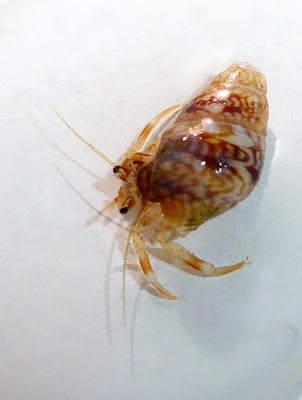Olivia and Tim, in the comments on that post, came up with a few more scenarios. The logs could have been washed up from some other source; the hermits could have massacred the snails after all (they have been known to do that in a pinch); or it could be a seasonal thing.
I'll have to start paying closer attention to numbers, dates, proportions, demographic ratios.
And I have more data to add; here goes.
As usual, I examined my hermits in a bowl of water before I added them to the tank. Three were quite tiny, and one was in a different shell, not from a mudsnail. I took its photo, before I settled it down in its new home.
 |
| Orange hermit in a matching shell, possibly an olive snail's shell. |
Hairy hermits crabs have green and white banded antennae, dark, hairy legs with variable white and/or blue markings.
 |
| Small hairy hermit in pretty moonsnail shell. |
 |
| Two of the orange hermits. The larger one is in a mudsnail shell. |
 |
| Zooming in. |
By the time I'd discovered this, the 5 new hermits had mingled with the old-timers. I looked for them in the tank, and discovered one of the tinies in an awkward position:
 |
| Caught on the back leg of a big shore crab. |
 |
| None the worse for wear. |
And sure enough, this one has the orange-tipped pincers and antennae, too.
The other common species, the grainyhand hermit, has orange antennae, but otherwise is quite different:
 |
| Bluish-green to brown legs and pincers, all covered with blue warts. These are larger hermits, up to 2 cm. They prefer big shells, like this whelk. |
This adds to the questions I have. Were all those hermits on the logs greenmarks? Why have I not seen any before? Do they, tiny as they are, kill snails?
We must go back and examine those logs properly.

I love following your crab tails.
ReplyDeleteI am always amazed at the detail in your photos, and these ones are no exception. Hermit crabs are really neat creatures, and you have fuelled my curiosity. Next time I see one (which is already a treat) I will pay more attention to its colours and features.
ReplyDeleteI found a few links on mud snails...
ReplyDeletehttp://books.google.ca/books?id=tUl5ESavtRIC&pg=PA362&lpg=PA362&dq=mud+snails+winter+pacific&source=bl&ots=3VkEMJjDol&sig=MbE9lBXzNIHbg9AcMQ7O1CKlBF0&hl=en&ei=phtDTcixJY66sAOghpWsCg&sa=X&oi=book_result&ct=result&resnum=1&ved=0CBUQ6AEwAA#v=onepage&q=mud%20snails%20winter%20pacific&f=false
http://www.vattenkikaren.gu.se/fakta/arter/mollusca/prosobra/hydrspp/hydrsp1e.html
Both seem to indicate either a hibernation or a die-off during winter. Mind you, the common name "mud snail" may refer to two different species between the two beaches you visited, hence different population patterns.